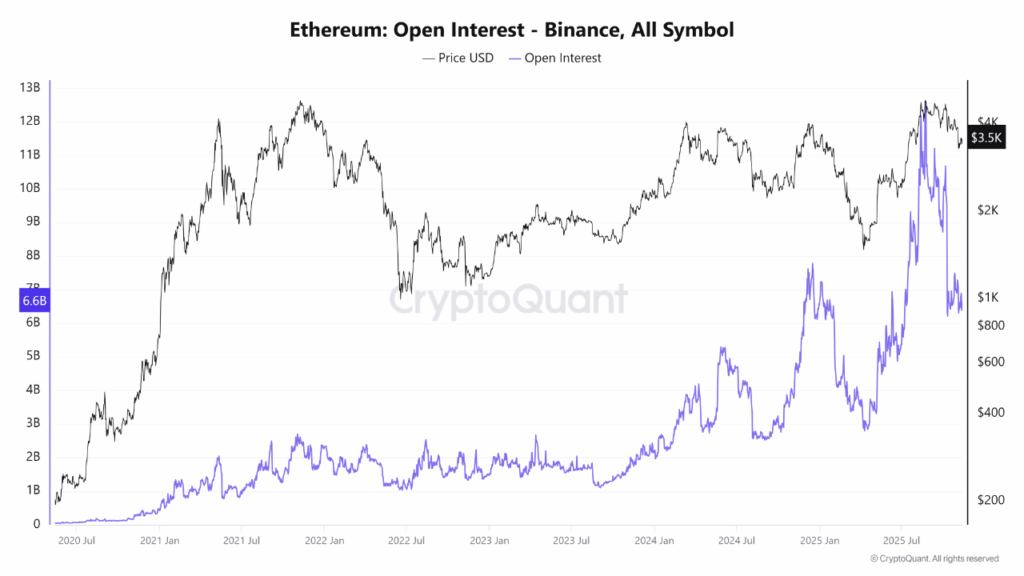Ethereum has entered what technical analysts describe as a “cooling phase”—a period marked by declining speculative activity and reduced derivatives exposure that may paradoxically position the asset for its next upward move.
Recent on-chain data reveals that Ethereum’s Open Interest has contracted significantly, a pattern that typically emerges when overleveraged positions unwind and risk appetite recedes across the derivatives market. This deleveraging process, while initially appearing bearish, often precedes periods of healthier, more sustainable price action.

Source: cryptoquant
The mechanics are straightforward: when Open Interest surges, speculative activity intensifies, amplifying volatility in both directions. As those positions close—whether through liquidations or deliberate exits—the market sheds its excess leverage. What remains is a derivatives environment with fewer crowded positions and reduced systemic risk. For Ethereum, this translates into a market structure better equipped to absorb buying pressure without the counterweight of aggressive short-term speculation.
Ethereum has established a robust support foundation near the $3,324 level, a price point that has repeatedly held through recent volatility. Technical indicators suggest this zone represents a demand cluster where large holders have been accumulating positions. As long as this support remains intact, the asset appears positioned to challenge the $3,700 resistance level—a threshold that has capped upward momentum in recent weeks.
The current market structure reveals several encouraging signals. Derivatives volume has moderated, indicating that traders are exercising greater discipline rather than piling into overleveraged bets. Open Interest figures have normalized, suggesting the market has moved past the speculative excess that characterized earlier periods. This reset creates conditions where directional moves are driven more by fundamental demand than by cascading liquidations.
Historical precedent supports this interpretation. Similar episodes of leverage flushing have preceded recovery phases, as the removal of speculative froth allows institutional capital and longer-term holders to establish positions without fighting against short-term noise. The reduction in Open Interest approaching double-digit percentages has historically coincided with market inflection points—moments where systemic risk declines and opportunities emerge for strategic accumulation.
The derivatives market structure also matters. Ethereum’s perpetual swap and futures markets have seen funding rates normalize, eliminating the persistent premium that long holders were paying during more euphoric phases. This equilibrium suggests the market is no longer overheated, reducing the probability of sudden reversals driven purely by financing costs.
However, challenges remain. Ethereum still needs to decisively break through the $3,700 resistance to confirm renewed bullish momentum. Failure to reclaim this level could result in extended consolidation or a retest of lower support zones around $3,285. The asset’s ability to convert resistance into support will be critical in determining whether this cooling phase transitions into a sustained rally.
On-chain metrics provide additional context. While decentralized exchange volumes have softened and total value locked has declined from recent highs, network fundamentals remain solid with approximately 16 million active addresses. This suggests the ecosystem retains its core user base even as speculative fervor has cooled.
The broader derivatives landscape shows Ethereum’s Open Interest has declined from approximately $46 billion in early November to around $38-41 billion currently, representing a meaningful contraction in leveraged exposure. This decline removes a significant overhang that had been weighing on price action, creating conditions where spot demand can exert greater influence on price discovery.
For institutional observers and tactical traders, the current environment presents a risk-reward profile that has improved materially from weeks prior. The purging of leverage reduces the likelihood of cascading liquidations, while technical support levels provide defined downside parameters. The test now is whether Ethereum can reclaim and hold above $3,700, which would open pathways toward the $3,880-$3,950 range and potentially reestablish bullish momentum.
The market has effectively undergone a reset—flushing overleveraged positions, normalizing funding rates, and establishing a support structure that could serve as a foundation for the next phase. Whether that phase materializes as a sustained rally or extended consolidation will depend on Ethereum’s ability to convert resistance into support and attract fresh capital beyond mere speculative positioning.
Disclaimer: This article is provided for informational purposes only and does not constitute financial advice. Investors should always conduct their own thorough research and consult with a qualified financial advisor before making any investment decisions in cryptocurrencies, which are highly volatile and speculative assets.
You might be interested in




